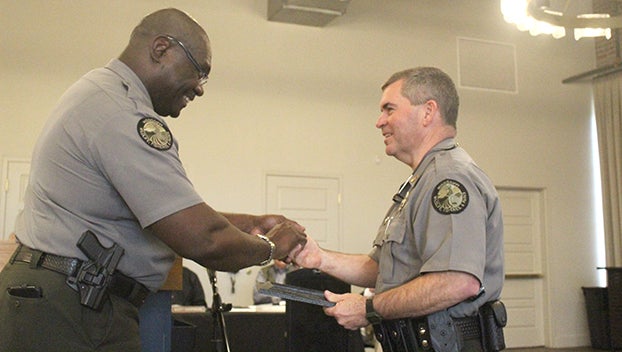As the train goes by
Published 10:24 am Friday, March 27, 2015

JULIA V. PENDLEY / Homer Richardson shares his knowledge with a group at the Jimmy Furlow Senior Center Thursday night. The event was sponsored by the Lincoln County Historical and Genealogical Society.
The sound of the train filled the room at the Jimmy Furlow Senior Center where a small group of people gathered for Homer Richardson’s presentation on the history of Brookhaven.
“I just want to emphasize the wonderful sound of the trains coming through,” Richardson said Thursday night.
Richardson is a history enthusiast and one of the members of the Lincoln County Historical and Genealogical Society.
Before the railroad was built that connected New Orleans and Memphis, Brookhaven was just one of many small villages scattered throughout the area.
As contractors began exploring the straightest path between Brookhaven and Memphis, the railroad approached Samuel Jayne. Although he is often credited as the founder of Brookhaven, he refused the railroad’s offer to purchase land.
Rev. Milton Whitworth realized the importance and offered up some of his land less than a mile away. The story goes that part of the agreement from the sale of land was that every train that comes through must stop in Brookhaven.
Once it was up and running, the railroad brought in industry, and Brookhaven became a center of commerce. A railroad was constructed between Brookhaven and Monticello along with several dummy lines connecting sawmills to the main line. At one time there were as many as 27 sawmills in the county.
Once the rails were laid down, A.E. Moreton was on the first train (“I love it when it’s the first, biggest or largest,” Richardson joked) from New Orleans. Whitworth was able to convince Moreton to stay and help develop Whitworth College. The college was known across the country as a top college for women due to its education and disciplinarian practices. Women were not allowed to walk around town alone.
Throughout the presentation, Richardson said emphasized that history is always changing. He explained history was much like a train passing through. As the passengers can be seen through the windows, they slowly morph through time.
Richardson showed the historical marker that describes Brookhaven’s foundation. The sign reads that dairy has been a major industry since the turn of the century.
“I don’t know where you’d go to find those cows,” Richardson joked.
As industry moved into town, houses began to crop up. Richardson said one of the most unique things about Brookhaven is the variety of architectural styles. Richardson also explained that picket fences arose out of necessity – to keep cattle out of the yard.
The first permanent commercial building was located at the site of the Inez. Later, when the Inez was built, it became the first brick building in Brookhaven. Richardson said in the early 1900s it was the most popular hotel between New Orleans and Jackson.
Another business that was popular throughout the region was McGrath’s store. John McGrath came to Brookhaven and made his money by working on the railroad. In the late 1870s, McGrath opened a large store.
“It was the Walmart at the time,” he said.
People would come from all over to shop at McGrath’s. Richardson said he read that they would throw chickens out in the street with price tags on them. When the chickens were brought back, the tag could be redeemed for merchandise.
During the Great Depression, Richardson said Brookhaven was hit hard. The town could have easily died at that point, but oil came in to save the day. In 1939, oil was discovered on what is now California Road. In the 1940s, oil was found near Mallalieu. Soon the oil industry in Brookhaven was booming.
Richardson said a more recent save came in the form of the Mississippi School of the Arts.
“I just want you to understand how close we came to losing all these beautiful buildings (on the old Whitworth campus),” he said.
With the introduction of the art school, the buildings were saved. Richardson also said that the recent interest in reviving the downtown area is important to help preserve the city’s history.
Richardson showed an old photo of the corner of Monticello Street and Railroad Avenue. He pointed out the building that Georgia Blue recently moved into. He said pretty soon the events and people now will be part of the passengers on the history train passing through.





